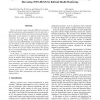Free Online Productivity Tools
i2Speak
i2Symbol
i2OCR
iTex2Img
iWeb2Print
iWeb2Shot
i2Type
iPdf2Split
iPdf2Merge
i2Bopomofo
i2Arabic
i2Style
i2Image
i2PDF
iLatex2Rtf
Sci2ools
122
click to vote
AINA
2009
IEEE
2009
IEEE
Impact of Power Control in Wireless Sensor Networks Powered by Ambient Energy Harvesting (WSN-HEAP) for Railroad Health Monitori
The use of wireless sensor networks (WSNs) for structural health monitoring is gaining popularity since it allows for a low-cost, rapid and robust assessment of structural integrity. Meanwhile, recent advances in ambient energy harvesting technology have made it a viable alternative source of energy for powering WSNs. WSNs powered by ambient energy harvesting (WSN-HEAP) are potentially more useful and economical in the long term than traditional batterypowered WSNs as they can operate for very long periods of time without the need for human involvement, thus paving the way towards alleviating energy constraints that continue to challenge WSNs. In this paper, we evaluate the impact of transmit power control on the usefulness of a multi-sink WSN-HEAP, deployed in uniform string topology for railway track monitoring. Based on current achievable energy harvesting rates from track deflections, and commercially available sensor mote parameters, our analysis reveals that availability can be ...
| Added | 12 Aug 2010 |
| Updated | 12 Aug 2010 |
| Type | Conference |
| Year | 2009 |
| Where | AINA |
| Authors | Hwee Pink Tan, Pius W. Q. Lee, Winston Khoon Guan Seah, Zhi Ang Eu |
Comments (0)

